NRSG370 - Clinical Integration: Melody King Colon Cancer Case Study
VerifiedAdded on 2023/06/09
|9
|2493
|323
Case Study
AI Summary
This case study focuses on Melody King, a 36-year-old patient diagnosed with colon cancer. The assignment details her presentation to the Emergency Department with severe abdominal pain, leading to emergency laparoscopic surgery for a ruptured appendix. The study explores her past medical history of asthma and depression, along with current medications. Post-surgery, Melody developed peritonitis, which was successfully treated. The biopsy confirmed adenocarcinoma, necessitating further diagnostic tests, including CT and MRI scans, and blood tests for tumor markers. The essay analyzes the patient's health information, nursing issues, priority goals (including colon cancer treatment, anterior resection syndrome, and bowel dysfunction), and nursing interventions, which involve surgical and medical management. The essay evaluates the nursing care strategies, discusses the challenges of bowel dysfunction and anterior resection syndrome, and reflects on the patient's outcomes, including the effectiveness of medications like loperamide. The study concludes with a summary of the case, emphasizing the importance of early intervention and comprehensive nursing care in managing colon cancer and its associated complications.
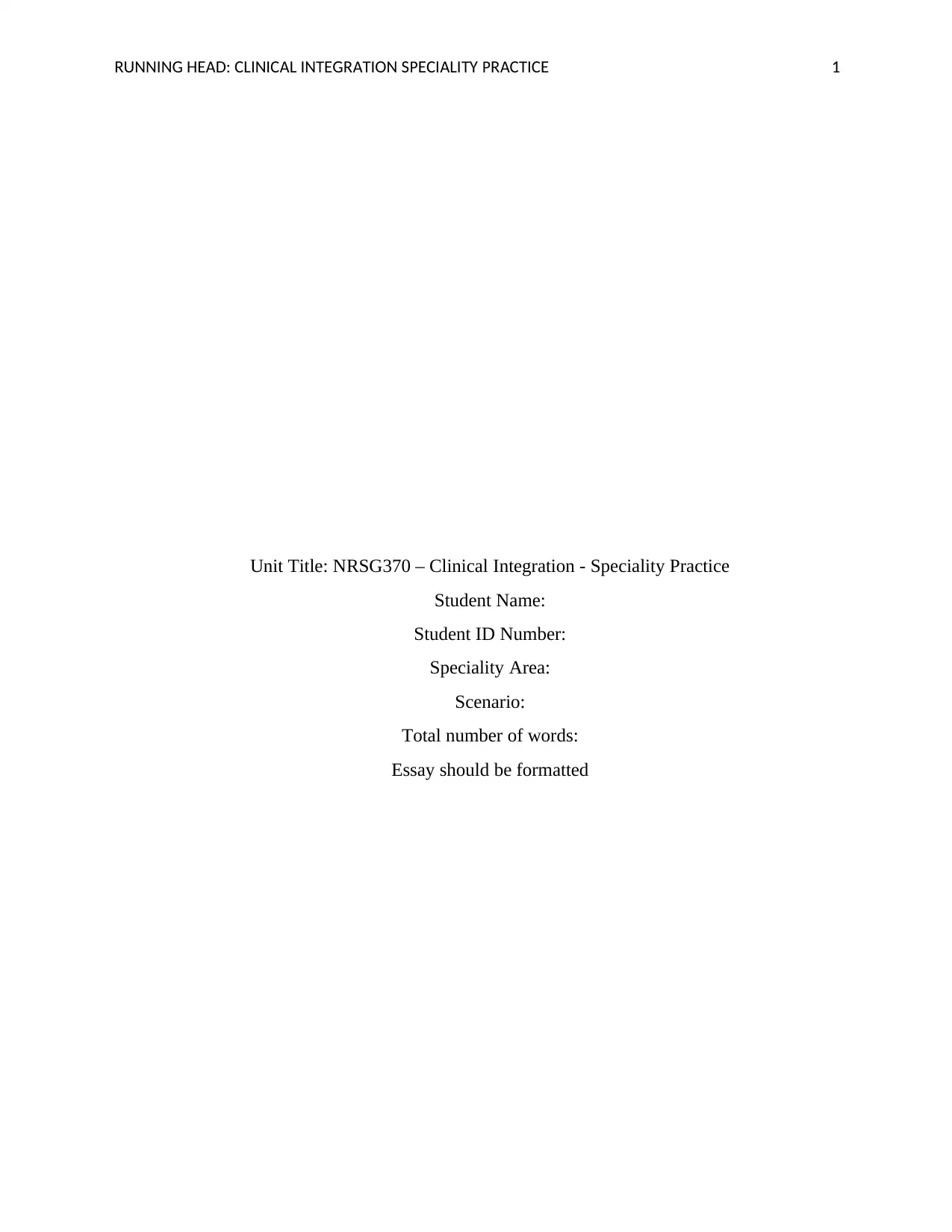
A A T AT P A T P A TRUNNING HE D: CLINIC L IN EGR ION S ECI LI Y R C ICE 1
Unit Title: NRSG370 – Clinical Integration - Speciality Practice
Student Name:
Student ID Number:
Speciality Area:
Scenario:
Total number of words:
Essay should be formatted
Unit Title: NRSG370 – Clinical Integration - Speciality Practice
Student Name:
Student ID Number:
Speciality Area:
Scenario:
Total number of words:
Essay should be formatted
Paraphrase This Document
Need a fresh take? Get an instant paraphrase of this document with our AI Paraphraser

A T AT P A T P A TCLINIC L IN EGR ION S ECI LI Y R C ICE 2
Clinical integration specialty practice
INTRODUCTION
Colon cancer is one of the most common types of cancers that affect both women and
men. According to statistics, 10% of the new cancers in the United States of America are colon
cancer while 12% of the cases appear in women (Kyu et al., 2016). In terms of mortality rates
among different types of cancer, colon cancer is ranked at position three (De Sousa e Melo et al.,
2017). The burden of colon cancer is immense and there is the urgent need to come up with
better nursing interventions to improve on the condition.
The essay will capture the related health information, the nursing issues or problems that
relate to the case study, the goals for priority, the nursing care for the patient as well as the
evaluation of the nursing strategies used .Finally, there will be a reflection on the patient’s
outcome.
THE CASE STUDY IN QUESTION
The situation that I came across was a patient by the name Melody King who was 36
years old and was suffering from colon cancer. She presented at the Emergency Department with
severe right lower quadrant abdominal pain and the situation required an urgent laparoscopic
surgery so that the raptured appendix could be removed. Her past medical history include asthma
as well as depression. Ventolin, sere tide and finally sertraline were the current medications for
the patient. Melody later developed peritonitis post-operative which was treated with different
antibiotics as well analgesia successfully. The presence of adenocarcinoma was confirmed day
three after the surgery on the biopsy of the appendix. Melody is supposed to return to the hospital
few days later so that a number of diagnostic tests could be done such as the CT scan of the
Clinical integration specialty practice
INTRODUCTION
Colon cancer is one of the most common types of cancers that affect both women and
men. According to statistics, 10% of the new cancers in the United States of America are colon
cancer while 12% of the cases appear in women (Kyu et al., 2016). In terms of mortality rates
among different types of cancer, colon cancer is ranked at position three (De Sousa e Melo et al.,
2017). The burden of colon cancer is immense and there is the urgent need to come up with
better nursing interventions to improve on the condition.
The essay will capture the related health information, the nursing issues or problems that
relate to the case study, the goals for priority, the nursing care for the patient as well as the
evaluation of the nursing strategies used .Finally, there will be a reflection on the patient’s
outcome.
THE CASE STUDY IN QUESTION
The situation that I came across was a patient by the name Melody King who was 36
years old and was suffering from colon cancer. She presented at the Emergency Department with
severe right lower quadrant abdominal pain and the situation required an urgent laparoscopic
surgery so that the raptured appendix could be removed. Her past medical history include asthma
as well as depression. Ventolin, sere tide and finally sertraline were the current medications for
the patient. Melody later developed peritonitis post-operative which was treated with different
antibiotics as well analgesia successfully. The presence of adenocarcinoma was confirmed day
three after the surgery on the biopsy of the appendix. Melody is supposed to return to the hospital
few days later so that a number of diagnostic tests could be done such as the CT scan of the
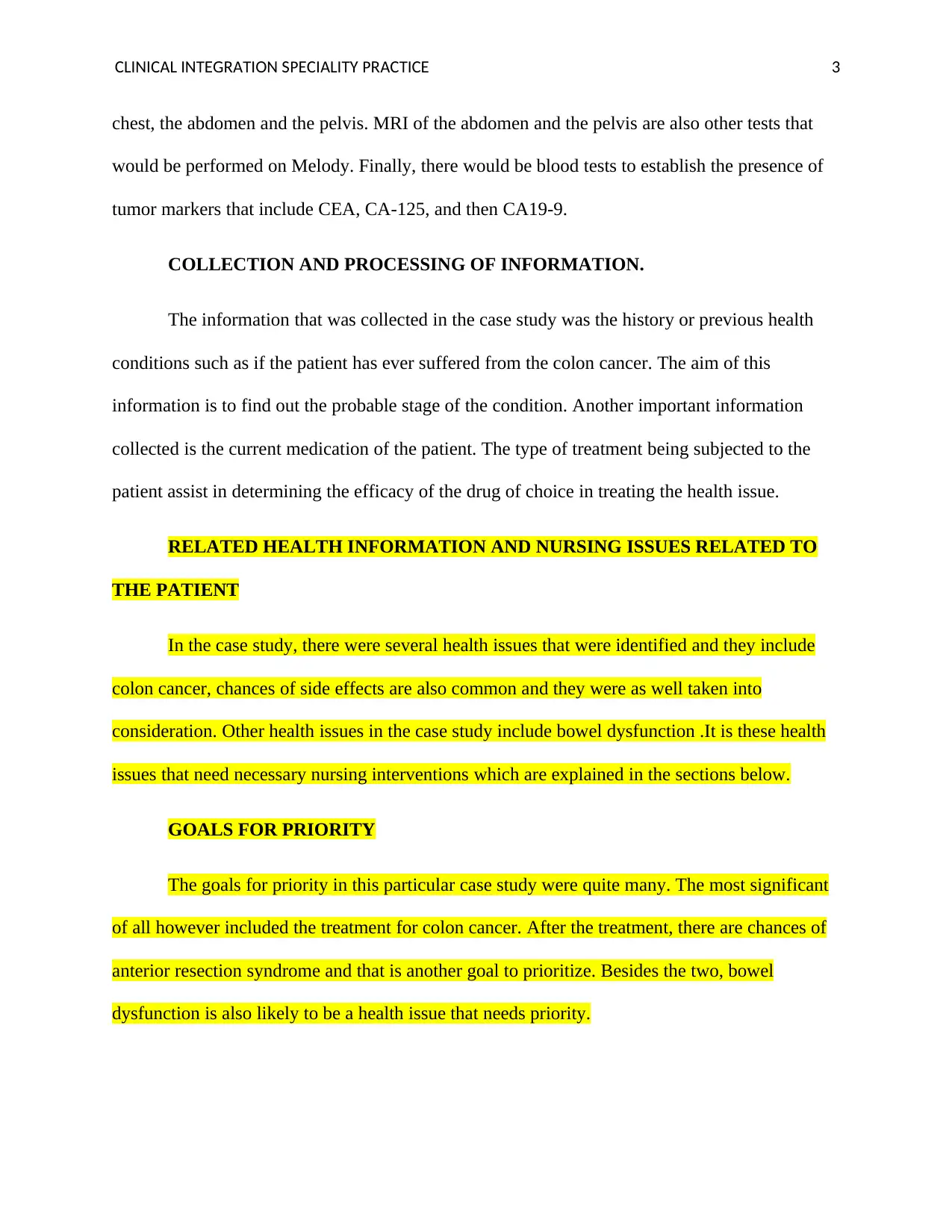
A T AT P A T P A TCLINIC L IN EGR ION S ECI LI Y R C ICE 3
chest, the abdomen and the pelvis. MRI of the abdomen and the pelvis are also other tests that
would be performed on Melody. Finally, there would be blood tests to establish the presence of
tumor markers that include CEA, CA-125, and then CA19-9.
COLLECTION AND PROCESSING OF INFORMATION.
The information that was collected in the case study was the history or previous health
conditions such as if the patient has ever suffered from the colon cancer. The aim of this
information is to find out the probable stage of the condition. Another important information
collected is the current medication of the patient. The type of treatment being subjected to the
patient assist in determining the efficacy of the drug of choice in treating the health issue.
RELATED HEALTH INFORMATION AND NURSING ISSUES RELATED TO
THE PATIENT
In the case study, there were several health issues that were identified and they include
colon cancer, chances of side effects are also common and they were as well taken into
consideration. Other health issues in the case study include bowel dysfunction .It is these health
issues that need necessary nursing interventions which are explained in the sections below.
GOALS FOR PRIORITY
The goals for priority in this particular case study were quite many. The most significant
of all however included the treatment for colon cancer. After the treatment, there are chances of
anterior resection syndrome and that is another goal to prioritize. Besides the two, bowel
dysfunction is also likely to be a health issue that needs priority.
chest, the abdomen and the pelvis. MRI of the abdomen and the pelvis are also other tests that
would be performed on Melody. Finally, there would be blood tests to establish the presence of
tumor markers that include CEA, CA-125, and then CA19-9.
COLLECTION AND PROCESSING OF INFORMATION.
The information that was collected in the case study was the history or previous health
conditions such as if the patient has ever suffered from the colon cancer. The aim of this
information is to find out the probable stage of the condition. Another important information
collected is the current medication of the patient. The type of treatment being subjected to the
patient assist in determining the efficacy of the drug of choice in treating the health issue.
RELATED HEALTH INFORMATION AND NURSING ISSUES RELATED TO
THE PATIENT
In the case study, there were several health issues that were identified and they include
colon cancer, chances of side effects are also common and they were as well taken into
consideration. Other health issues in the case study include bowel dysfunction .It is these health
issues that need necessary nursing interventions which are explained in the sections below.
GOALS FOR PRIORITY
The goals for priority in this particular case study were quite many. The most significant
of all however included the treatment for colon cancer. After the treatment, there are chances of
anterior resection syndrome and that is another goal to prioritize. Besides the two, bowel
dysfunction is also likely to be a health issue that needs priority.
⊘ This is a preview!⊘
Do you want full access?
Subscribe today to unlock all pages.

Trusted by 1+ million students worldwide
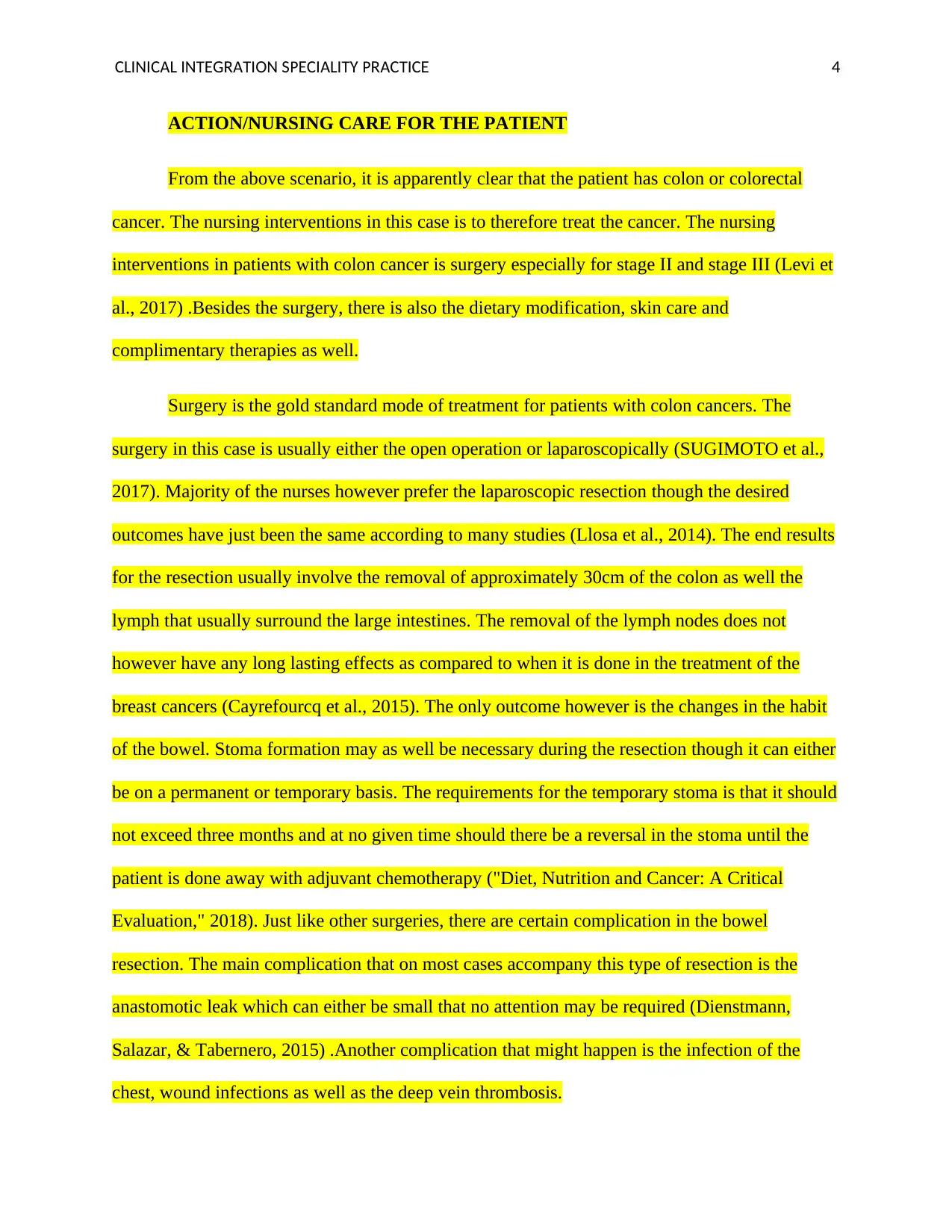
A T AT P A T P A TCLINIC L IN EGR ION S ECI LI Y R C ICE 4
ACTION/NURSING CARE FOR THE PATIENT
From the above scenario, it is apparently clear that the patient has colon or colorectal
cancer. The nursing interventions in this case is to therefore treat the cancer. The nursing
interventions in patients with colon cancer is surgery especially for stage II and stage III (Levi et
al., 2017) .Besides the surgery, there is also the dietary modification, skin care and
complimentary therapies as well.
Surgery is the gold standard mode of treatment for patients with colon cancers. The
surgery in this case is usually either the open operation or laparoscopically (SUGIMOTO et al.,
2017). Majority of the nurses however prefer the laparoscopic resection though the desired
outcomes have just been the same according to many studies (Llosa et al., 2014). The end results
for the resection usually involve the removal of approximately 30cm of the colon as well the
lymph that usually surround the large intestines. The removal of the lymph nodes does not
however have any long lasting effects as compared to when it is done in the treatment of the
breast cancers (Cayrefourcq et al., 2015). The only outcome however is the changes in the habit
of the bowel. Stoma formation may as well be necessary during the resection though it can either
be on a permanent or temporary basis. The requirements for the temporary stoma is that it should
not exceed three months and at no given time should there be a reversal in the stoma until the
patient is done away with adjuvant chemotherapy ("Diet, Nutrition and Cancer: A Critical
Evaluation," 2018). Just like other surgeries, there are certain complication in the bowel
resection. The main complication that on most cases accompany this type of resection is the
anastomotic leak which can either be small that no attention may be required (Dienstmann,
Salazar, & Tabernero, 2015) .Another complication that might happen is the infection of the
chest, wound infections as well as the deep vein thrombosis.
ACTION/NURSING CARE FOR THE PATIENT
From the above scenario, it is apparently clear that the patient has colon or colorectal
cancer. The nursing interventions in this case is to therefore treat the cancer. The nursing
interventions in patients with colon cancer is surgery especially for stage II and stage III (Levi et
al., 2017) .Besides the surgery, there is also the dietary modification, skin care and
complimentary therapies as well.
Surgery is the gold standard mode of treatment for patients with colon cancers. The
surgery in this case is usually either the open operation or laparoscopically (SUGIMOTO et al.,
2017). Majority of the nurses however prefer the laparoscopic resection though the desired
outcomes have just been the same according to many studies (Llosa et al., 2014). The end results
for the resection usually involve the removal of approximately 30cm of the colon as well the
lymph that usually surround the large intestines. The removal of the lymph nodes does not
however have any long lasting effects as compared to when it is done in the treatment of the
breast cancers (Cayrefourcq et al., 2015). The only outcome however is the changes in the habit
of the bowel. Stoma formation may as well be necessary during the resection though it can either
be on a permanent or temporary basis. The requirements for the temporary stoma is that it should
not exceed three months and at no given time should there be a reversal in the stoma until the
patient is done away with adjuvant chemotherapy ("Diet, Nutrition and Cancer: A Critical
Evaluation," 2018). Just like other surgeries, there are certain complication in the bowel
resection. The main complication that on most cases accompany this type of resection is the
anastomotic leak which can either be small that no attention may be required (Dienstmann,
Salazar, & Tabernero, 2015) .Another complication that might happen is the infection of the
chest, wound infections as well as the deep vein thrombosis.
Paraphrase This Document
Need a fresh take? Get an instant paraphrase of this document with our AI Paraphraser
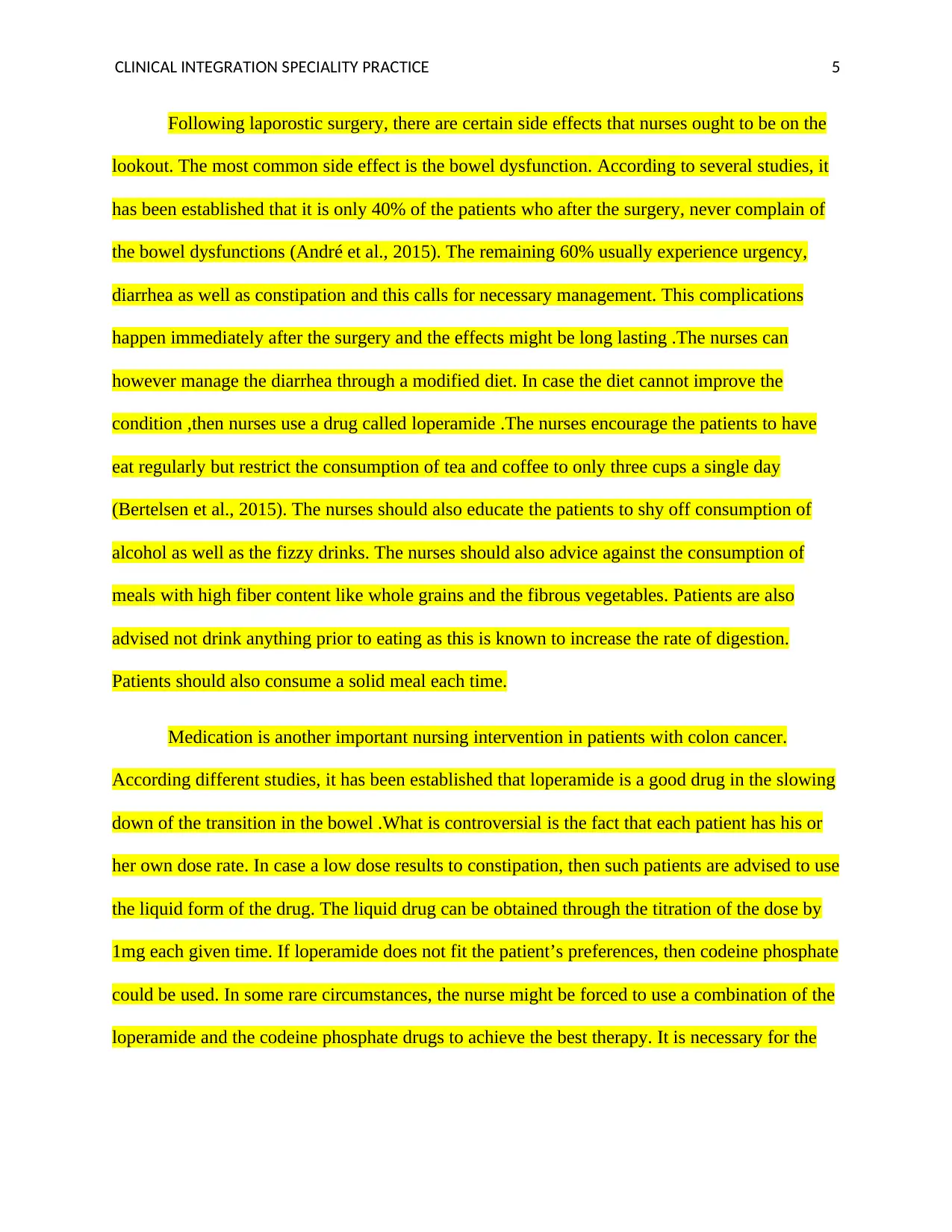
A T AT P A T P A TCLINIC L IN EGR ION S ECI LI Y R C ICE 5
Following laporostic surgery, there are certain side effects that nurses ought to be on the
lookout. The most common side effect is the bowel dysfunction. According to several studies, it
has been established that it is only 40% of the patients who after the surgery, never complain of
the bowel dysfunctions (André et al., 2015). The remaining 60% usually experience urgency,
diarrhea as well as constipation and this calls for necessary management. This complications
happen immediately after the surgery and the effects might be long lasting .The nurses can
however manage the diarrhea through a modified diet. In case the diet cannot improve the
condition ,then nurses use a drug called loperamide .The nurses encourage the patients to have
eat regularly but restrict the consumption of tea and coffee to only three cups a single day
(Bertelsen et al., 2015). The nurses should also educate the patients to shy off consumption of
alcohol as well as the fizzy drinks. The nurses should also advice against the consumption of
meals with high fiber content like whole grains and the fibrous vegetables. Patients are also
advised not drink anything prior to eating as this is known to increase the rate of digestion.
Patients should also consume a solid meal each time.
Medication is another important nursing intervention in patients with colon cancer.
According different studies, it has been established that loperamide is a good drug in the slowing
down of the transition in the bowel .What is controversial is the fact that each patient has his or
her own dose rate. In case a low dose results to constipation, then such patients are advised to use
the liquid form of the drug. The liquid drug can be obtained through the titration of the dose by
1mg each given time. If loperamide does not fit the patient’s preferences, then codeine phosphate
could be used. In some rare circumstances, the nurse might be forced to use a combination of the
loperamide and the codeine phosphate drugs to achieve the best therapy. It is necessary for the
Following laporostic surgery, there are certain side effects that nurses ought to be on the
lookout. The most common side effect is the bowel dysfunction. According to several studies, it
has been established that it is only 40% of the patients who after the surgery, never complain of
the bowel dysfunctions (André et al., 2015). The remaining 60% usually experience urgency,
diarrhea as well as constipation and this calls for necessary management. This complications
happen immediately after the surgery and the effects might be long lasting .The nurses can
however manage the diarrhea through a modified diet. In case the diet cannot improve the
condition ,then nurses use a drug called loperamide .The nurses encourage the patients to have
eat regularly but restrict the consumption of tea and coffee to only three cups a single day
(Bertelsen et al., 2015). The nurses should also educate the patients to shy off consumption of
alcohol as well as the fizzy drinks. The nurses should also advice against the consumption of
meals with high fiber content like whole grains and the fibrous vegetables. Patients are also
advised not drink anything prior to eating as this is known to increase the rate of digestion.
Patients should also consume a solid meal each time.
Medication is another important nursing intervention in patients with colon cancer.
According different studies, it has been established that loperamide is a good drug in the slowing
down of the transition in the bowel .What is controversial is the fact that each patient has his or
her own dose rate. In case a low dose results to constipation, then such patients are advised to use
the liquid form of the drug. The liquid drug can be obtained through the titration of the dose by
1mg each given time. If loperamide does not fit the patient’s preferences, then codeine phosphate
could be used. In some rare circumstances, the nurse might be forced to use a combination of the
loperamide and the codeine phosphate drugs to achieve the best therapy. It is necessary for the
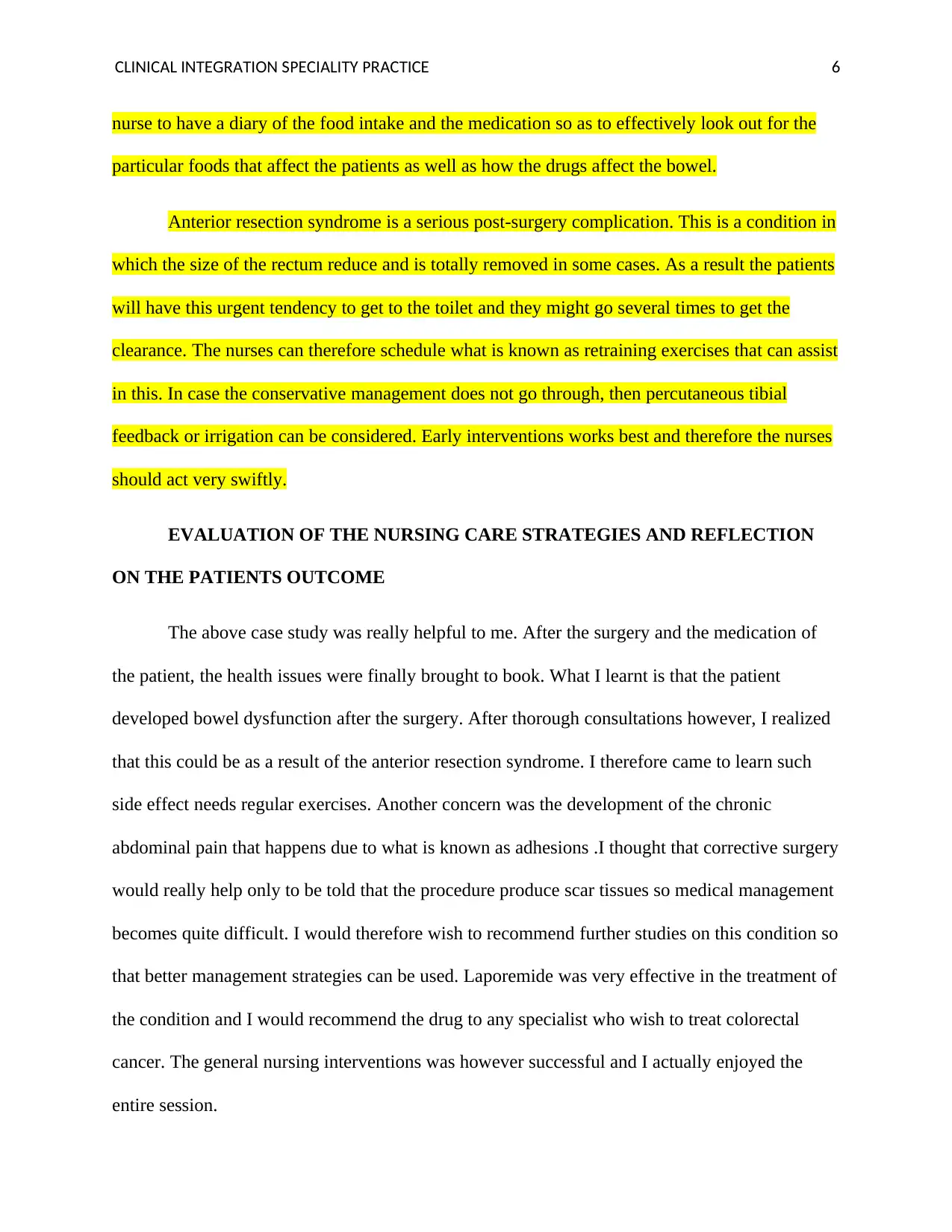
A T AT P A T P A TCLINIC L IN EGR ION S ECI LI Y R C ICE 6
nurse to have a diary of the food intake and the medication so as to effectively look out for the
particular foods that affect the patients as well as how the drugs affect the bowel.
Anterior resection syndrome is a serious post-surgery complication. This is a condition in
which the size of the rectum reduce and is totally removed in some cases. As a result the patients
will have this urgent tendency to get to the toilet and they might go several times to get the
clearance. The nurses can therefore schedule what is known as retraining exercises that can assist
in this. In case the conservative management does not go through, then percutaneous tibial
feedback or irrigation can be considered. Early interventions works best and therefore the nurses
should act very swiftly.
EVALUATION OF THE NURSING CARE STRATEGIES AND REFLECTION
ON THE PATIENTS OUTCOME
The above case study was really helpful to me. After the surgery and the medication of
the patient, the health issues were finally brought to book. What I learnt is that the patient
developed bowel dysfunction after the surgery. After thorough consultations however, I realized
that this could be as a result of the anterior resection syndrome. I therefore came to learn such
side effect needs regular exercises. Another concern was the development of the chronic
abdominal pain that happens due to what is known as adhesions .I thought that corrective surgery
would really help only to be told that the procedure produce scar tissues so medical management
becomes quite difficult. I would therefore wish to recommend further studies on this condition so
that better management strategies can be used. Laporemide was very effective in the treatment of
the condition and I would recommend the drug to any specialist who wish to treat colorectal
cancer. The general nursing interventions was however successful and I actually enjoyed the
entire session.
nurse to have a diary of the food intake and the medication so as to effectively look out for the
particular foods that affect the patients as well as how the drugs affect the bowel.
Anterior resection syndrome is a serious post-surgery complication. This is a condition in
which the size of the rectum reduce and is totally removed in some cases. As a result the patients
will have this urgent tendency to get to the toilet and they might go several times to get the
clearance. The nurses can therefore schedule what is known as retraining exercises that can assist
in this. In case the conservative management does not go through, then percutaneous tibial
feedback or irrigation can be considered. Early interventions works best and therefore the nurses
should act very swiftly.
EVALUATION OF THE NURSING CARE STRATEGIES AND REFLECTION
ON THE PATIENTS OUTCOME
The above case study was really helpful to me. After the surgery and the medication of
the patient, the health issues were finally brought to book. What I learnt is that the patient
developed bowel dysfunction after the surgery. After thorough consultations however, I realized
that this could be as a result of the anterior resection syndrome. I therefore came to learn such
side effect needs regular exercises. Another concern was the development of the chronic
abdominal pain that happens due to what is known as adhesions .I thought that corrective surgery
would really help only to be told that the procedure produce scar tissues so medical management
becomes quite difficult. I would therefore wish to recommend further studies on this condition so
that better management strategies can be used. Laporemide was very effective in the treatment of
the condition and I would recommend the drug to any specialist who wish to treat colorectal
cancer. The general nursing interventions was however successful and I actually enjoyed the
entire session.
⊘ This is a preview!⊘
Do you want full access?
Subscribe today to unlock all pages.

Trusted by 1+ million students worldwide
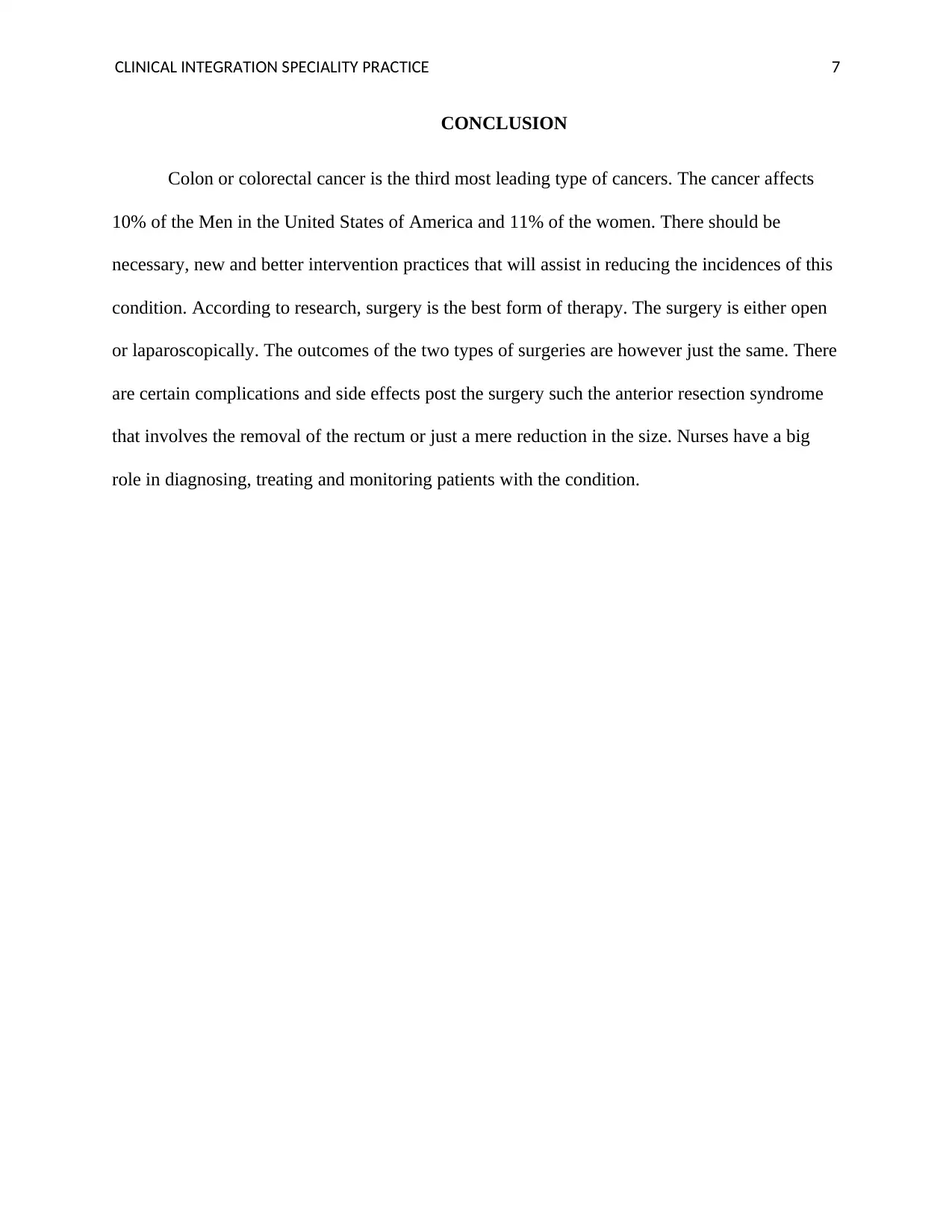
A T AT P A T P A TCLINIC L IN EGR ION S ECI LI Y R C ICE 7
CONCLUSION
Colon or colorectal cancer is the third most leading type of cancers. The cancer affects
10% of the Men in the United States of America and 11% of the women. There should be
necessary, new and better intervention practices that will assist in reducing the incidences of this
condition. According to research, surgery is the best form of therapy. The surgery is either open
or laparoscopically. The outcomes of the two types of surgeries are however just the same. There
are certain complications and side effects post the surgery such the anterior resection syndrome
that involves the removal of the rectum or just a mere reduction in the size. Nurses have a big
role in diagnosing, treating and monitoring patients with the condition.
CONCLUSION
Colon or colorectal cancer is the third most leading type of cancers. The cancer affects
10% of the Men in the United States of America and 11% of the women. There should be
necessary, new and better intervention practices that will assist in reducing the incidences of this
condition. According to research, surgery is the best form of therapy. The surgery is either open
or laparoscopically. The outcomes of the two types of surgeries are however just the same. There
are certain complications and side effects post the surgery such the anterior resection syndrome
that involves the removal of the rectum or just a mere reduction in the size. Nurses have a big
role in diagnosing, treating and monitoring patients with the condition.
Paraphrase This Document
Need a fresh take? Get an instant paraphrase of this document with our AI Paraphraser
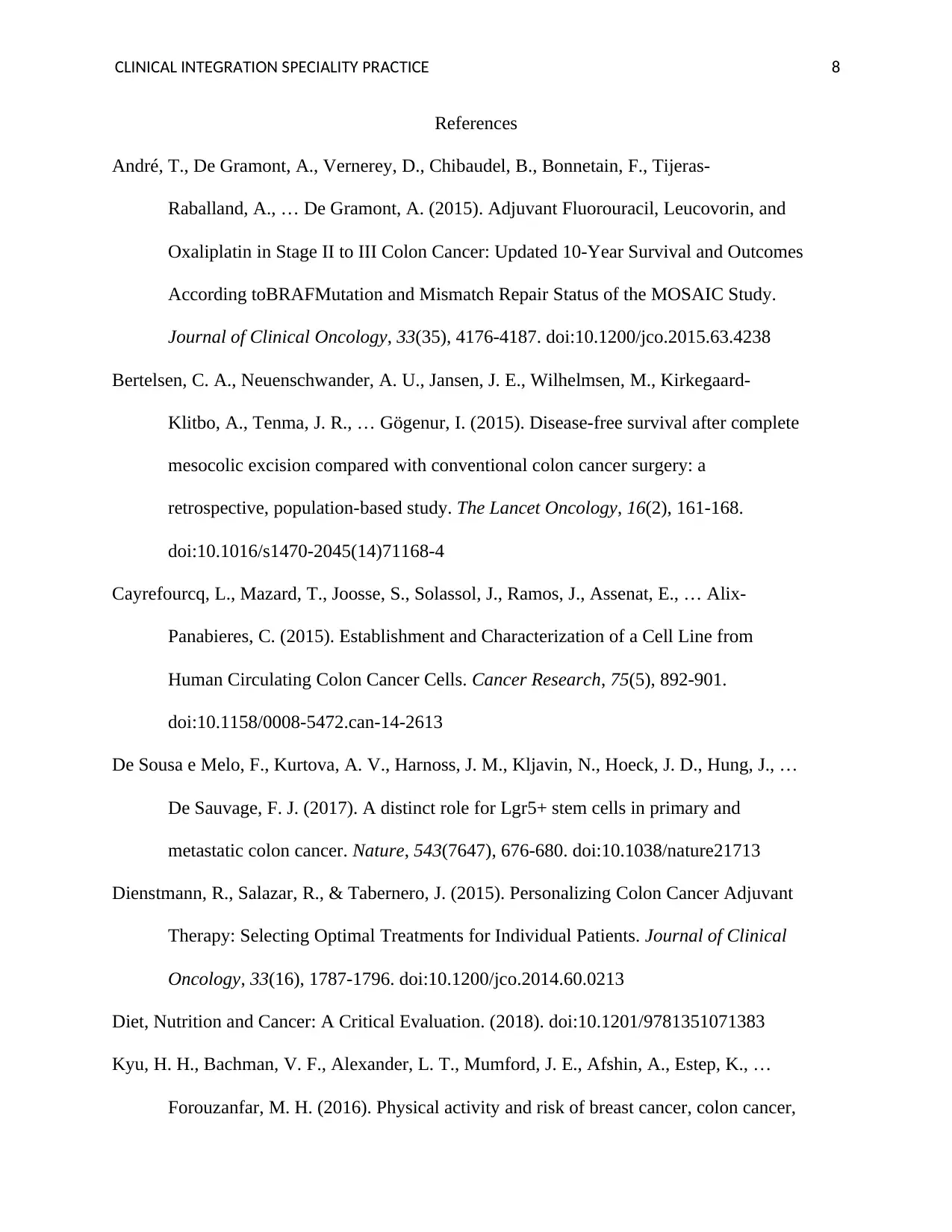
A T AT P A T P A TCLINIC L IN EGR ION S ECI LI Y R C ICE 8
References
André, T., De Gramont, A., Vernerey, D., Chibaudel, B., Bonnetain, F., Tijeras-
Raballand, A., … De Gramont, A. (2015). Adjuvant Fluorouracil, Leucovorin, and
Oxaliplatin in Stage II to III Colon Cancer: Updated 10-Year Survival and Outcomes
According toBRAFMutation and Mismatch Repair Status of the MOSAIC Study.
Journal of Clinical Oncology, 33(35), 4176-4187. doi:10.1200/jco.2015.63.4238
Bertelsen, C. A., Neuenschwander, A. U., Jansen, J. E., Wilhelmsen, M., Kirkegaard-
Klitbo, A., Tenma, J. R., … Gögenur, I. (2015). Disease-free survival after complete
mesocolic excision compared with conventional colon cancer surgery: a
retrospective, population-based study. The Lancet Oncology, 16(2), 161-168.
doi:10.1016/s1470-2045(14)71168-4
Cayrefourcq, L., Mazard, T., Joosse, S., Solassol, J., Ramos, J., Assenat, E., … Alix-
Panabieres, C. (2015). Establishment and Characterization of a Cell Line from
Human Circulating Colon Cancer Cells. Cancer Research, 75(5), 892-901.
doi:10.1158/0008-5472.can-14-2613
De Sousa e Melo, F., Kurtova, A. V., Harnoss, J. M., Kljavin, N., Hoeck, J. D., Hung, J., …
De Sauvage, F. J. (2017). A distinct role for Lgr5+ stem cells in primary and
metastatic colon cancer. Nature, 543(7647), 676-680. doi:10.1038/nature21713
Dienstmann, R., Salazar, R., & Tabernero, J. (2015). Personalizing Colon Cancer Adjuvant
Therapy: Selecting Optimal Treatments for Individual Patients. Journal of Clinical
Oncology, 33(16), 1787-1796. doi:10.1200/jco.2014.60.0213
Diet, Nutrition and Cancer: A Critical Evaluation. (2018). doi:10.1201/9781351071383
Kyu, H. H., Bachman, V. F., Alexander, L. T., Mumford, J. E., Afshin, A., Estep, K., …
Forouzanfar, M. H. (2016). Physical activity and risk of breast cancer, colon cancer,
References
André, T., De Gramont, A., Vernerey, D., Chibaudel, B., Bonnetain, F., Tijeras-
Raballand, A., … De Gramont, A. (2015). Adjuvant Fluorouracil, Leucovorin, and
Oxaliplatin in Stage II to III Colon Cancer: Updated 10-Year Survival and Outcomes
According toBRAFMutation and Mismatch Repair Status of the MOSAIC Study.
Journal of Clinical Oncology, 33(35), 4176-4187. doi:10.1200/jco.2015.63.4238
Bertelsen, C. A., Neuenschwander, A. U., Jansen, J. E., Wilhelmsen, M., Kirkegaard-
Klitbo, A., Tenma, J. R., … Gögenur, I. (2015). Disease-free survival after complete
mesocolic excision compared with conventional colon cancer surgery: a
retrospective, population-based study. The Lancet Oncology, 16(2), 161-168.
doi:10.1016/s1470-2045(14)71168-4
Cayrefourcq, L., Mazard, T., Joosse, S., Solassol, J., Ramos, J., Assenat, E., … Alix-
Panabieres, C. (2015). Establishment and Characterization of a Cell Line from
Human Circulating Colon Cancer Cells. Cancer Research, 75(5), 892-901.
doi:10.1158/0008-5472.can-14-2613
De Sousa e Melo, F., Kurtova, A. V., Harnoss, J. M., Kljavin, N., Hoeck, J. D., Hung, J., …
De Sauvage, F. J. (2017). A distinct role for Lgr5+ stem cells in primary and
metastatic colon cancer. Nature, 543(7647), 676-680. doi:10.1038/nature21713
Dienstmann, R., Salazar, R., & Tabernero, J. (2015). Personalizing Colon Cancer Adjuvant
Therapy: Selecting Optimal Treatments for Individual Patients. Journal of Clinical
Oncology, 33(16), 1787-1796. doi:10.1200/jco.2014.60.0213
Diet, Nutrition and Cancer: A Critical Evaluation. (2018). doi:10.1201/9781351071383
Kyu, H. H., Bachman, V. F., Alexander, L. T., Mumford, J. E., Afshin, A., Estep, K., …
Forouzanfar, M. H. (2016). Physical activity and risk of breast cancer, colon cancer,
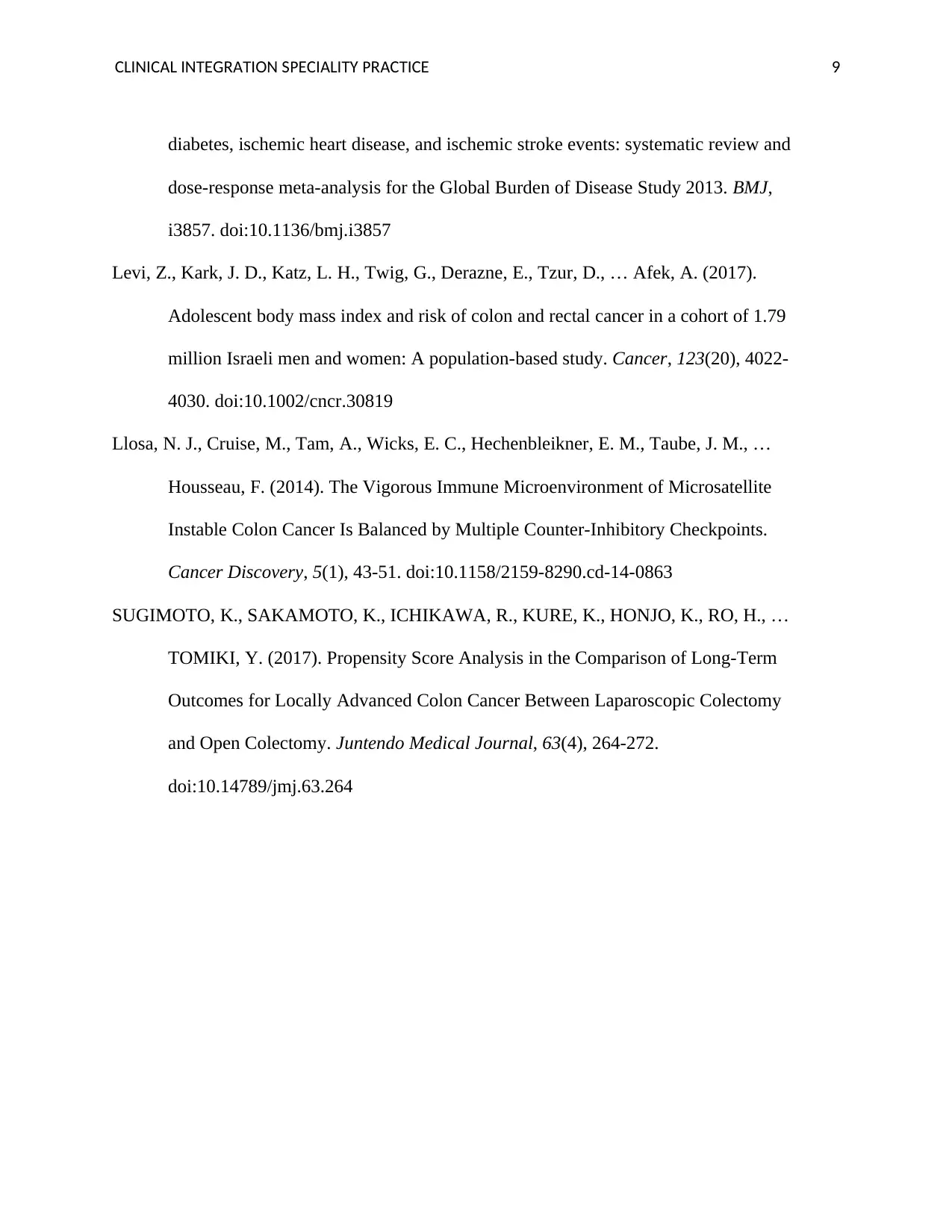
A T AT P A T P A TCLINIC L IN EGR ION S ECI LI Y R C ICE 9
diabetes, ischemic heart disease, and ischemic stroke events: systematic review and
dose-response meta-analysis for the Global Burden of Disease Study 2013. BMJ,
i3857. doi:10.1136/bmj.i3857
Levi, Z., Kark, J. D., Katz, L. H., Twig, G., Derazne, E., Tzur, D., … Afek, A. (2017).
Adolescent body mass index and risk of colon and rectal cancer in a cohort of 1.79
million Israeli men and women: A population-based study. Cancer, 123(20), 4022-
4030. doi:10.1002/cncr.30819
Llosa, N. J., Cruise, M., Tam, A., Wicks, E. C., Hechenbleikner, E. M., Taube, J. M., …
Housseau, F. (2014). The Vigorous Immune Microenvironment of Microsatellite
Instable Colon Cancer Is Balanced by Multiple Counter-Inhibitory Checkpoints.
Cancer Discovery, 5(1), 43-51. doi:10.1158/2159-8290.cd-14-0863
SUGIMOTO, K., SAKAMOTO, K., ICHIKAWA, R., KURE, K., HONJO, K., RO, H., …
TOMIKI, Y. (2017). Propensity Score Analysis in the Comparison of Long-Term
Outcomes for Locally Advanced Colon Cancer Between Laparoscopic Colectomy
and Open Colectomy. Juntendo Medical Journal, 63(4), 264-272.
doi:10.14789/jmj.63.264
diabetes, ischemic heart disease, and ischemic stroke events: systematic review and
dose-response meta-analysis for the Global Burden of Disease Study 2013. BMJ,
i3857. doi:10.1136/bmj.i3857
Levi, Z., Kark, J. D., Katz, L. H., Twig, G., Derazne, E., Tzur, D., … Afek, A. (2017).
Adolescent body mass index and risk of colon and rectal cancer in a cohort of 1.79
million Israeli men and women: A population-based study. Cancer, 123(20), 4022-
4030. doi:10.1002/cncr.30819
Llosa, N. J., Cruise, M., Tam, A., Wicks, E. C., Hechenbleikner, E. M., Taube, J. M., …
Housseau, F. (2014). The Vigorous Immune Microenvironment of Microsatellite
Instable Colon Cancer Is Balanced by Multiple Counter-Inhibitory Checkpoints.
Cancer Discovery, 5(1), 43-51. doi:10.1158/2159-8290.cd-14-0863
SUGIMOTO, K., SAKAMOTO, K., ICHIKAWA, R., KURE, K., HONJO, K., RO, H., …
TOMIKI, Y. (2017). Propensity Score Analysis in the Comparison of Long-Term
Outcomes for Locally Advanced Colon Cancer Between Laparoscopic Colectomy
and Open Colectomy. Juntendo Medical Journal, 63(4), 264-272.
doi:10.14789/jmj.63.264
⊘ This is a preview!⊘
Do you want full access?
Subscribe today to unlock all pages.

Trusted by 1+ million students worldwide
1 out of 9
Related Documents
Your All-in-One AI-Powered Toolkit for Academic Success.
+13062052269
info@desklib.com
Available 24*7 on WhatsApp / Email
![[object Object]](/_next/static/media/star-bottom.7253800d.svg)
Unlock your academic potential
Copyright © 2020–2025 A2Z Services. All Rights Reserved. Developed and managed by ZUCOL.





